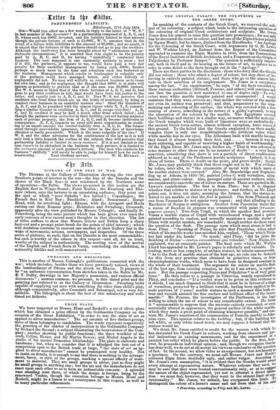THE CRYSTAL PALACE : THE co/oval:NG Op
THE GREEK CONN%
In speaking of the contents of the Greek Court, we reserved the sub- ject of its colouring : a subject which.leads to the interesting question of the colouring of original Greek architecture and sculpture. Mr. Owea Jones does his utmost to raise this question into prominence ; for not only has he decorated the court in colour, and had one of the Elgin friezes painted by Signor Monti, but he issues, distinct from the Handbooks, " An Apology for the Colouring of the Greek Court, with Arguments by G. H. Lewes and W. Watkins Lloyd, an Extract from the Report of the Committee appointed to examine the Elgin Marbles in 1836, from the Transactions of the Royal Institute of British Architects, and a Fragment on the Origin of Polychromy by Professor Semper." The question is sufficiently import. ant, both in itself and in its bearing on the future of art, to induce us to refer in some detail to the facts brought out in the "Apology," There are three parties in the discussion : those who deny that the Greeks did use colour ; those who admit a degree of colour, but stop short of be- lieving in entirely painted statues; and those who go to the utmost lati- tude in their assertion of its employment. Mr. Jones is a coryplismis among the last. "An examination,' he says, "of the facts recorded by these various authorities [Hittorff, Penrose, and others] will convince any one that the question is now narrowed to one of degree only—To what extent were white marble temples painted and ornamented ? I would maintain that they were entirely so ; that neither the colour of the marble nor even its surface was preserved ; and that, preparatory to the erns. menting and colouring of the surface, the whole was covered with a thin coating of stucco, something in the nature of a gilder's ground, to step the absorption of the colours by the marble. The Egyptians covered their buildings and statues in a similar way, no matter what the material: the Greek temples which were built of limestone were so undoubtedly; the ancient Greek terra-cottas, almost without exception, have traces of this ground. To the belief that the Greeks employed it on their marble temples there is only one stumblingblock—the artificial value which White marble has in our eyes. The Athenians built with marble because they found it almost beneath their feet, and . . . . because it was the most enduring, and capable of receiving a higher finish of workmanship." Of the Elgin frieze Mr. Jones says, further on, "That it was coloured in some manner or other there can be no manner of doubt" : a very broad assertion, considering that there is not a particle of direct confirmation adduced as to any of the Parthenon marble sculptures. Indeed, it is an abuse of terms. There is doubt on the point, and grave doubt ; though Mr. Jones may probably think that there ought not to be. For evidence he refers, inter alga, to " the ornaments of metal with which many of the marble statues were covered." Also, Mr. Bracebridge saw fragments dug up at Athens, in 1835-'36, painted [when ?] with vermilion, ultra- marine, and straw-colour. Also, passages exist in ancient authors, which are considered to assert the use of colour on statues. These are quoted in Mr. Lewes's contribution. The first is from Plato : but it is disputed whether that relates to statues or to pictures; and further, as Mr. Lloyd points out, it does not state, assuming the former, that the statues re- ferred to are marble, or that the flesh is painted. One from Plutarch and one from Pausanias do not appear very cogent; and that alluding to the Bacchante of Scopes is ambiguous. Another from Pausanias states that a statue of Bacchus in gypsum was ornamented with paint (EirtlasKag' 1.1.11FEYOU vpachn.) Two from Virgil, in which the speaker first promises Venus a marble statue of Cupid with varicoloured wings and a quiver painted according to custom, and secondly mentions a marble statue of Diana with scarlet sandals, are remarkable ; though neither do these reach the question of the flesh. The passage upon which most stress is laid is from Pliny. " Speaking of Nicias, he says that Praxiteles, when asked which of his marble works best satisfied him, replied, ' Those which Nicias has had under his hands.' So much,' says Pliny, did he prize the finishing of Nicias'—tantrn circumlitioni Citi8 tribuebat." Now Nicias,itis explained, was an encaustic painter. The final note which Mr. Watkiss Lloyd has appended to Mr. Lewes's paper is scholarly and valuable. Co- louring, more or less complete, of archaic statues, he admits unreservedlY. " As to the flesh of marble statues of the best age, no rule can be deduced for this from any practice that obtained in primitive times, or from chryselephantine works, which seem to have been in designed contrast in the whole of their treatment. The argument for colour on marble flesh of the best age, from existing remains, so far as I am aware, is equal to zero. But the passage respecting Nieias and Polycletus* is of very great force." He then refers to a passage in Vitruvius, nearly reproduced m Pliny, and concludes—"If a verdict were to be given on this evidence as it stands, I am much disposed to think that it must be in favour of a tinge of vermilion, protected by a brilliant varnish, having been applied te the nude portions of (? some) marble statues in such a manner that both co- lour and varnish assisted the fine surface and brilliant effect of, the lucent marble." Mr. Penrose, the investigator of the Parthenon, is the least willing to admit the use of colour to any considerable extent. He holds it "unreasonable to suppose that the ancients entirely concealed, or even materially altered in appearance, the general surface of the white marble, which they made a great point Of obtaining whenever: possible," and con- tests Mr. Jones's assertion of the commonness of Pentelic marble to Athe- nian eyes. This opinion relates to the building; but, if the building was left white, or only white toned down, we may suppose a fortiori that the statues would be. We think Mr. Jones entitled to credit for the success with which be has decorated his Greek Court in colours, working from obscure and Par- tial indications in existing monuments, and for the experiment of a painted bas-relief which, he places before the public. In the first, how- ever, he proceeds on individual opinion ; and, though we recognize that he has done well, we do not at all accept his views as conclusive on the question of fact. In the second, we allow value as an experiment, but not beautyas a specimen. On the contrary, we must call Messrs. Jones and Mantis coloured Elgin frieze decidedly ugly, and rather vulgar. According to Mr. Jones's own assumption, "it is evident that the Greeks would avoid every attempt at representing nature. Whatever colours they used, we may be sure that they were treated conventionally only, so as to snail' the nature of the object represented, yet not to attempt a direct imita- tion : we must feel, however, that they went to the utmost limit of con- ventionality." Mr. Jones, we submit, has overpassed this limit. 1, distinguish the colour of a horse's mane and tail from that of his. Mal e-Prerieeles, according to Intro, au44.11xJawea• generally, by painting the former of a dark brown approaching black, Th.& the latter is a warm reddish brown, is surely a strong symptom of realism; to paint the draperies in various colours, with borders again of a different hue, is surely a strong symptom of painting for painting's sake. Tbat thew colours are found in draperies on Greek terra-cottas, appears nothing to the purpose ; in them there is no fear of realism. The fact is, as Mr. Jones makes a point of premising for his own excuse, the experi- ment could not be properly tried with such a material as plaster. We can conceive that marble painted-or, as seems to us almost inevitably better, stained-with fine colours, transparent on the transparent stir-
face, would have a very different effect : but, in either case, we would advo- cate greater subordination and simplicity in the hues than Signor Monti has displayed. To his fully-coloured group we clearly prefer that where the background only has been painted blue, and to both the one which has been left untouched.
There seems unquestionably to be valid, though not conclusive ground for believing that the Greeks did colour their statues to a large extent ; and if so, best probably over the whole surface. But after all, the practical question for living artiste is not What did the Greeks do? but What ought we to do? and we cannot admit that the decision is furthered by any Greek practice in the matter. Idealism, anti-realism, anti-naturalism, are theories of art maintained often blindly and illegitimately ; but they have their true aide nevertheless ; and, among the forms of art, sculpture is the one most decidedly to which they are applicable at any rate. Painting allows of, in- deed demands, a very considerable amount of realism, though it must not be realism and nothing else : but this form of art is saved from ever being altogether realistic by the fact that it does not possess absolute form. Sculpture, on the contrary, does possess absolute form. Form is form ; and a statue, it has been truly observed by Guizot, is not an imitation of the form of a man, but literally the form of a man, no less than the flesh and blood. This fact makes it most dangerous to proceed a step further on the road to realism ; and any amount of colour is a very serious step. Of course, such colour as that of bronze does not count ; for of the two, it is less realistic to have a man one uniform burnished surface of golden olive-colour than one uniform surface of white. But any separation of colours with even an approach to the natural hue is unmistakeably realistic. It may be " conventional " as colour, yet realistic as colour coming in aid of absolute form. Actual instead oirepresented form, actual instead of represented lights and shadows, and colour approaching the ac- tual in denomination and distribution, however modified in tone, bring the statue so far on the read to realism, that one scarcely knows whether it were not better to take the remaining steps. Mere faint stains of co- lour and carefully bestowed gilding are on a somewhat different footing. Our argument applies, however, even to them : but, of course, we are not contending against colour in architecture, or the harmonizing, within limits, of the sculpture with the building to which it belongs. Mr. Jones inquires-" How can one believe that, at one particular period in the practice of the arts, the artistic eye was so entirely changed that it became suddenly enamoured of white marble ? Such an idea be- longs only to an age like that through which we have just passed-an age equally devoid of the capacity to appreciate and of the power to execute works of art-when refuge is taken in whitewashing." We need not observe that this is just begging the fact and the right of the question both together. But are even the data tenable Did no noble mediaeval men carve uncoloured stone before the revival of the classic taste ? or were Nimbi Pisano, and Verrocchio, and Donatello, and Michel Angelo, born in an age without capacity or power, for which whitewash was the only resource ?



































 Previous page
Previous page